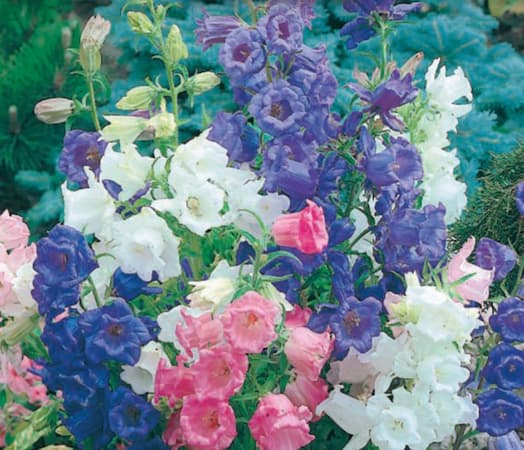How to Grow Canterbury Bells Flower Plants

About Growing Canterbury Bells Plants in Your Home Flower Garden
Biennial Canterbury Bells plants are easy-to-grow flowers, that reward you with elegant, showy blooms. When growing Canterbury Bells flowers, you need to have patience. As a biennial, the plants produce sweet-scented, bell-shaped flower blooms up to 2 inches across in the summer of the second year after planting. To have yearly blooms, it is important to continually plant these flowers each year.
Canterbury Bells look great in the back of the flower garden. They fit right in when planted in a cottage garden. They are not used as container plants because they only bloom in the second year of growth. You can grow them in groups of single colors. Or, plant mixed colors together. Either way, they look great when in bloom. The flowers have a sweet scent. Plant them near a window so you can enjoy the scent as it wafts into your home.
FYI: For new gardeners, you’re probably familiar with the terms annual and perennial. However, “Biennial” may be a new term to you. Biennial plants live for two years. The flowers normally bloom in the second year. There aren’t a lot of species of biennial flowers.
Canterbury Bells Plant Specifications
Flower Colors include pink, white, purple, lavender, blue, and violet.
Flowers Bloom: Summer
Plant Height: 18″ – 36″
Light Requirements: Full sun to partial sun.
Ideal Soil pH: 6.0 – 8.0.
Hardiness Zone: 5 – 8.
Toxicity: The plant and flowers are non-toxic.
Native To: Europe
Plant Type: Biennial
Botanical Name: Campanula Medium
Are Canterbury Bells Edible?
Yes!!
The leaves, roots, and young shoots are edible. In Korea, the roots are a delicacy. Eat them raw or cooked. Also, the roots can be dried for later use.
The petals are candied and used to decorate cakes, cupcakes, and other desserts.
Canterbury Bells Medicinal Uses
There are several medicinal applications for this plant. The flowers, leaves, and roots have anti-inflammatory and diuretic properties. The medicinal applications include treatment for:
- Asthma
- Colds
- Digestive problems
- Fever
- Hypertension
- Kidney Stones
- Urinary tract infections
Biennial Canterbury Bells Plant Propagation
Canterbury Bells plants are grown from seeds. Sow seeds early in the season. Or, start seeds indoors 4-6 weeks before the last frost in your area. Keep the top of the soil moist during the germination period.
To have continuous blooms every year, allow some of the flower seed pods to mature. Then, let the seed fall to the ground to re-seed the flower bed. They are good re-seeders.
Also, you can harvest mature Canterbury Bells seeds for planting next year in another location. Then, after harvesting the seeds, let them dry a little longer on a screen in a cool, dry location.
Days to Germination: 14 – 21 days.
Light Requirements
The plants grow best in full sunlight. For a healthy plant and flowers, it needs several hours of direct sunlight. Canterbury Bells tolerate partial sunlight. In the hottest areas of the country, shelter them from the hot afternoon sun.
How to Grow Canterbury Bells Flower Plants
Grow the plants in full to partial sun. Plants prefer cooler weather. If grown in warmer, southerly areas of he country, provide afternoon shade or filtered sunlight.
Select a planting location where the plants can grow for many ears. Mix in a generous amount of compost at the planting site. Canterbury Bells plants are heavy feeders. The plants prefer nutrient-rich, moist soil that is well-drained.
Established plants are drought tolerant. They like evenly moist soil. Do not allow the soil to become wet and soggy for extended periods of time as this will cause root rot. However, water them during extended periods of drought.
The plants are heavy feeders. For best flower production, fertilize every month or two during the growing season. Use a nitrogen-rich fertilizer early in the growing season. Then, switch to a fertilizer high in phosphorous to encourage blooms to develop.
Mulch around plants for a neat and tidy appearance, and to keep competing weeds down. Then, as the mulch decomposes, it feeds the plant.
Pruning Canterbury Bells Plants
Remove any dead, unsightly, or sick leaves and stems, as needed.
Thin plants to improve air circulation. This helps to prevent plant diseases.
Deadhead spent blooms. This improves the appearance of the plant and t encourages new blooms to grow.
More on Deadheading Plants.
Insects and Plant Disease
Occasional infestations include aphids, mites, slugs, and snails. Slug and snail bait is effective. For other insects treat with an insecticidal soap as needed.
Root rot can occur in wet or soggy soils, especially if it is wet for an extended period. Powdery mildew can occur in humid weather. Rust can also be an occasional problem.
How to Overwinter Plants
At the end of the first year, if the plants have grown large, lightly trim it back.
In colder regions, add a thick layer of mulch to help protect the roots of the plants.
Related Articles
Also, people who read this article will like:
Plant Problems – Identify the causes and find the cures.
Please support our site. Shop for:
- rmmatthews100@hotmail.com
- 585-721-6528
- Rochester, NY
©1999-2024 GardenersNet.Com, All Rights Reserved

